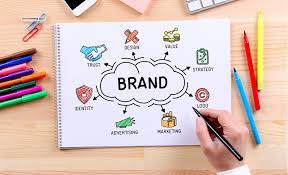Ever wondered why certain brands’ logos evoke feelings of trust, adventure, or comfort, contributing to a strong brand image? Successful brands often have a brand name that resonates with these sentiments. That’s the power of successful brands—a force that goes beyond just a company’s name, products, or even its business model. Certain brands harness this through a robust marketing strategy. It’s about the brand image, the experience, the personality the product exudes, and how it connects with its audience and clients. On the flip side, a business is your start-to-finish game plan for entrepreneurs; it’s all about providing a service or product that fills a gap in the market, enhancing your company’s brand image through strategic marketing. Together, the company and product weave an intricate dance of purpose and perception, shaping not just what you sell but how your community sees your image. We’re diving into this dynamic duo of company strategy and product innovation to reveal how they each play their part in catapulting your brand to market success, engaging clients, and captivating your audience.
Brand and Business Defined
Brand Is Perception
In the bustling marketplace, a brand’s name is like a promise to customers, embodying the company’s product image. It’s what people associate with our company’s brand image when they see our logo or hear our name, reflecting the human aspect we embody. Consider it the brand image of your company, akin to a human personality that resides in the minds of consumers. It’s not just about slapping on a cool logo; it’s about crafting a brand image that resonates with the human aspect, creating an emotional connection that sticks for your company.
A stellar brand name can make your company stand out in a crowd and resonate with the human touch. Ever notice how some brands become household names? That’s no accident. The company has worked hard to build trust and loyalty with its customers, turning first-time buyers into lifelong fans.
Business Means Structure
Now, let’s talk shop – literally! A company is the nuts and bolts of making money. It’s the whole shebang: from the company idea spark to selling stuff, managing company money, and keeping company customers happy. This company is where we get down to brass tacks with things like business models and operations.
If you’re a company owner or dreaming of becoming one, you’ve got to juggle a lot. You need a solid plan for how you’ll run your company’s show – whether it’s a small business or something bigger. And remember, every successful company starts with a strong foundation.
Core Differences Highlighted
So here’s the skinny on brand vs business within a company: they’re two sides of the same coin but play different tunes in the company structure. Your company’s brand essence is all about vibes – how people perceive your company and feel about what you offer. Meanwhile, your company’s business operations are all about action – getting things done and moving product.
To put it another way: if your company’s brand was a person, it’d be their style and charm that wins friends at parties. But their day job? That’s pure company business – showing up on time and getting work done.
Examples Speak Louder
Picture this: two lemonade stand companies side by side in Anytown, USA. One company has just “Lemonade” scrawled across its banner; that’s basic branding 101 right there. The other company has “Sunny Smiles Lemonade,” with bright colors and a catchy jingle playing softly in the background; now that’s company branding with pizzazz!
Guess which one gets more foot traffic? Yep, Sunny Smiles company wins because people dig that warm fuzzy feeling even before tasting their drink.
Significance of Brand in Business Growth
Companies’ brands are the heartbeats of their businesses, pumping out loyalty and setting prices. This company is like a magnet in a world full of iron—pulling customers in and standing out.
Customer Loyalty Kingpin
Think about your favorite sneaker brand. Why do you keep going back? It’s not just about the company’s shoes; it’s the vibe they give off. A strong company brand is like your best friend—it sticks around through thick and thin. And when you trust a company’s brand, you don’t mind paying a little extra for that high-five feeling.
Companies with killer brands can charge more because people believe they’re worth it. It’s simple: company love equals company loyalty equals more company cash in the register.
Outshine the Competition
Now, imagine walking down a company’s aisle packed with cereal boxes. Which one do you grab? The company with the cool mascot you know and love, right? That’s what successful companies do through their brands—they ensure you reach for them even when there are tons of options from other companies trying to catch your eye.
In places where everyone seems to sell the same thing, a strong brand is like wearing neon at a black-and-white party—you stand out! Companies that invest in their brand can dance circles around others stuck in the “just another option” zone.
Expansion Rocket Fuel
Ever seen a small shop turn into an empire? That’s brand equity at work—it’s like magic beans for business growth. When people dig your brand, they spread the word faster than wildfire. This buzz opens doors to new markets and opportunities without having to start from scratch every time.
Brand equity isn’t just fluff; it’s solid business sense backed by numbers. It means when you say “jump,” customers say “how high?” And that kind of power can take businesses places they’ve only dreamed of.
Operations: Business vs Brand
Businesses thrive on operational efficiency while brands grow through creativity. Systems and processes run a business; stories and connections build a brand.
Operational Efficiency Key
Operational efficiency is like the engine in a car for businesses. It’s all about doing things faster, better, and with fewer resources. Think of it as the behind-the-scenes magic that keeps everything running smoothly. Companies invest big bucks in software and tech to streamline their workflows.
Creativity Drives Brands
On the flip side, brands are all about being bold and standing out from the crowd. They rely on wild ideas and eye-catching designs to grab attention. A brand’s mission is to make you feel something special when you see their logo or hear their name.
Backbone of Functionality
For any business, having solid systems and processes is non-negotiable. It’s like the rules of a sport – without them, things would be chaos! These systems ensure orders get filled, bills get paid, and customers stay happy.
Storytelling Wins Hearts
But hey, what’s a good product without a killer story? Brand operations focus on spinning tales that stick in your mind long after you’ve seen an ad or visited a website. It’s about creating a vibe that people want to be part of.
Consumer Engagement Focus
Brands also have another trick up their sleeve: they’re ace at getting folks talking. Whether it’s through social media shout-outs or epic customer service moves, they know how to keep people coming back for more.
Brand Identity vs Business Strategy
Brand identity and business strategy are two sides of the same coin. One creates a visual and emotional connection; the other navigates the competitive marketplace.
Identity Shapes Recognition
Your brand is like your face in a crowd. It’s what people see and remember. The logo, colors, and design – that’s your brand identity. It’s how customers spot you from miles away. Think about Nike’s swoosh or McDonald’s golden arches. You see them, and bam! You know who they are.
Strategy Dictates Approach
Now, let’s talk about game plans – that’s your business strategy. It’s all about making moves to win in the market jungle. Your strategy might be to offer the best prices or maybe to make something so cool everyone just has to have it.
Branding Influences Behavior
When folks feel good about your brand, they stick around longer and buy more stuff. A solid brand identity can make someone choose your sneakers over another pair just because they dig your style.
Strategy Targets Profitability
While branding plays with feelings, strategy zeroes in on the cash. It asks questions like “How do we sell more?” or “What price will max out our profits?” The goal? To make sure those dollars keep rolling in.
Visuals Create Identity
A killer logo or a catchy slogan can work wonders for your identity. They’re like secret handshakes that tell a story about who you are without using many words.
Planning Steers Growth
Strategic planning is where you get down to brass tacks. It’s plotting out every step needed to grow bigger and better than before.
Myths and Misconceptions in Branding
Branding is more than just a logo, and high-quality products alone don’t create a strong brand. Both small and large businesses need effective branding to stand out.
Logo Isn’t Brand Identity
A logo is a symbol. It’s like the cherry on top of the cake that is your brand. But it’s not the whole dessert. A brand identity is the full experience consumers have with your business – it’s how they feel when they think about you.
For example, think of successful brands like Nike or Apple. Their logos are iconic, sure. But their brand identity? That’s a whole world of marketing, design, and emotion that resonates with consumers everywhere.
Quality Doesn’t Equal Presence
So you’ve got a great product? Awesome! But if no one knows about it, how will it sell? High-quality products don’t automatically come with customer recognition or loyalty.
Certain brands shine because they connect quality with storytelling. They share their journey, making customers part of their world. This builds presence – something that merely good products can’t do on their own.
Small Biz Needs Big Branding
“Only big fish need to look pretty,” some say. They’re wrong! Small businesses need branding as much as giants like Coca-Cola or McDonald’s do.
Here’s why: In a sea of competition, branding helps small businesses swim to the surface. It gives them personality and makes them memorable to consumers who crave connections with who they buy from.
Transitioning from Business to Brand
Unique Voice Matters
Owning a business? Cool. Turning it into a brand? That’s next level. What makes you different from the next Joe selling the same stuff? Your voice, that’s what. It’s not just about what you say; it’s how you say it. Think of your favorite brands – they talk to you, not at you, right?

Imagine walking into two different coffee shops. One greets you with a warm “What can I get for ya?” The other, just a plain old “Next!” Which one would you go back to? That’s the power of having a unique voice.
Core Values Shine Through
Your values are like your business’s heartbeat. They keep everything alive and kicking. When customers interact with your business, they should feel those values in every chat, click, and purchase.
Let’s say honesty is your jam. If something goes wrong with an order, being upfront about it can turn an “ugh” moment into a “wow” one for your customer. It shows them they’re dealing with real folks who care.
Beyond Basic Commerce
Selling stuff is great but creating experiences? That’s where the magic happens. You want people to feel something when they think of your business – happy, excited, comforted… anything but bored!
Think of that cereal brand that takes you back to Saturday mornings as a kid or the phone company whose ads make you laugh out loud. They’re not just selling; they’re storytelling.
Legal and Image Considerations
Protecting your brand is about more than just a cool logo. It’s about making sure you’re legally covered too.
Trademarking and Compliance
Trademarking isn’t just a fancy word; it’s your superhero shield. It keeps copycats at bay by protecting the stuff that makes your brand unique, like your logo or slogan. Imagine if anyone could use Mickey Mouse’s ears for their mouse traps – chaos! That’s why trademarks are a big deal.
On the flip side, running a business without tripping over legal wires is like playing hopscotch in a minefield. You gotta stay on top of laws and regulations to keep things smooth. Think health codes for restaurants or safety standards for toys. They might not be fun, but they’re essential to avoid fines or, worse, shutting down.
Public Relations and Regulation
Ever heard the phrase “all publicity is good publicity”? Well, that’s not always true. Your brand image is like your reputation at school – you want it to be cool, not infamous. Public relations (PR) pros work magic to make sure people see the best side of your brand.
Business credibility is all about playing by the rules. If you cut corners with taxes or ignore employment laws, trust me, it’ll bite back hard. Customers dig businesses that play fair – it shows reliability and builds trust.
Intellectual Property and Licenses
Branding thrives on creativity – that’s where intellectual property (IP) comes into play. IP is like claiming dibs on an idea; it says this genius invention or catchy jingle came from your brain first.
But what about day-to-day operations? That’s where licenses come in handy. They’re permission slips from Uncle Sam saying you can run your business without getting detention… I mean fines or penalties.
Conclusion
You’ve seen the ropes – brand and business are two sides of the same coin, but they play different games. A brand is your business’s face, the vibe it sends out to the world. It’s what sticks in people’s minds, like that catchy tune you can’t shake. Your business? That’s the engine under the hood, all the nuts and bolts that keep things running smooth. They’ve got to work together, or it’s like trying to drive with flat tires – you won’t get far.
So what’s your next move? Think about your own biz. Is your brand turning heads or just blending in? It’s time to step up your game and make sure your brand’s not just another face in the crowd. Let’s make some noise and turn your solid business into a rockstar brand! Ready to rock? Let’s chat and crank up the volume on your success story.
FAQs
What’s the difference between a brand and a business?
A brand is like your reputation, it’s how people recognize and experience what you offer. A business is the structure or machine that delivers products or services.






